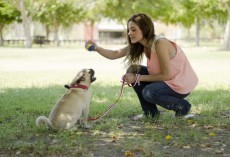When walking your pooch around the neighborhood, make sure you know where he can go to the bathroom. If there are only certain spots make sure to only allow him to eliminate there. You may have to train him with a certain phrase letting him know where it's okay to go. Check out more tips below:
How to properly promenade your pooch in public
City-dwelling dogkeepers are faced with greater challenges than their suburban and rural counterparts. Without a large, fenced yard for exercise, the city dweller must take to the streets three or more times a day with Fido or Fifi in tow. The following tips will make walks safer and more enjoyable for you, your dog and your neighbors.
It's the Law
Most cities and counties have some form of leash, license and pick-up-after-your-dog laws. These ordinances are designed to protect both the dog and the community at large.
Licensing a dog enables an animal control agency to return a lost pet to his rightful owner.
Pooper-scooper laws are essential for both the health and beautification of the community. Train your dog to urinate in gutters or on nonliving vertical surfaces, such as lampposts or hydrants. Avoid trees and flowerbeds.
Etiquette Lessons and Safety Tips
The well-trained city dog needs to respond to a minimum of four basic commands: “Sit-Stay,” “Heel,” “Leave it” and “Come.”
Contact your local shelter for a referral to a class near you.
Remember that dogs can be frightened by sudden loud noises, such as running children, motorcycles, skateboarders and in-line skaters, to name a few.
Before leaving home to run errands with your dog by your side, take a moment to consider which places permit dogs and which do not.
Remember the Good Neighbor Policy
Keep in mind that not everyone loves dogs, so it's up to the urban dogkeeper to present a dog who is well-socialized and under control.
Many dogs enjoy the company of other canines, but always ask before allowing your animal to launch himself at another dog—for both their sakes. If your dog is physically challenging, consider using a head halter for better control.
On the other hand, with a little training and thoughtfulness, more businesses and public areas will begin to put out the welcome mat for both you and your dog.
Not all people like dogs, so when you're outside your living quarters with Fido train him how to sit and “leave it.” Phrases like this will alert him to sit and stay and leave something that he's curious about. For example, if a person does not want your pooch to come near their child, pay attention to her body language and have your pooch stay out of the way.
It's more effort having a doggy in the city, but he's worth it! Take extra precautions to make sure he's safe and trained and you'll have no problem thriving and loving your city life. Check out more tips on Fido etiquette on ASPCA.










